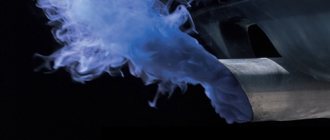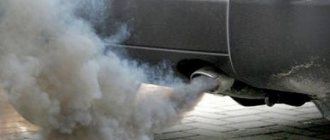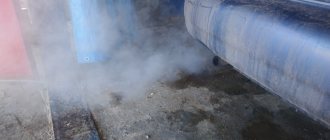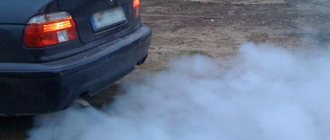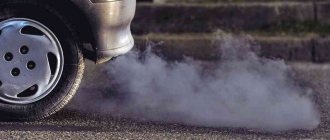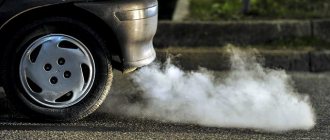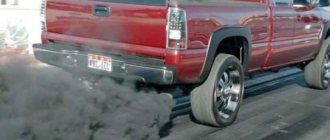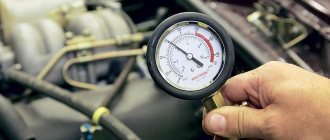In cold weather, the exhaust tract of a working internal combustion engine emits whitish steam or a slightly noticeable gray smoke: on a clear, warm day the exhausts are transparent. However, the color of emissions can be black, white, and can vary from light blue to dark blue.
What does blue smoke from the exhaust pipe of a gasoline engine portend, what are the reasons for its appearance, as well as the consequences for the engine - questions of interest to owners of cars of different brands - Largus and Lexus, Toyota, Prior.
What does blue smoke in a gasoline engine mean?
The shade of smoke indicates a problem in a specific module of the vehicle. If thick white puffs indicate a malfunction of the cooling system, then the causes of blue smoke from the exhaust pipe of a gasoline engine lie in the area of the cylinder-piston group (CPG).
Causes and effects of blue smoke
The bluish exhaust also suggests the idea of delving into the valve mechanism. The culprit of the problem is oil that has penetrated into the cylinders in one way or another.
The nature of smoke and the degree of wear of the power unit
Experienced specialists, based on their own observations or the client’s descriptions of the characteristics of smoke, can with a high degree of probability guess the nature of the problem. Let's look at a few common cases :
- If the blue-white exhaust appears only when the engine warms up and gradually disappears as it warms up, then there is no reason to fear serious wear of the mechanisms. This effect is explained by the ability of parts to expand; when heated, the gaps decrease and oil leakage stops.
- In the case when, after warming up the power unit, smoking not only continues, but also intensifies, it can be argued that there is significant wear of the internal combustion engine elements. The reason is the following - the expansion is not enough to reliably seal the gaps and through them hot oil easily penetrates into the cylinders.
Blue smoke from the exhaust pipe - where does it come from?
It’s not for nothing that such an exhaust is called “oil”: blue smoke from the muffler is accompanied by a “guzzling” of engine lubrication. The trouble, however, is not the high cost of a canister of consumables, but the serious problems of the gasoline-powered internal combustion engine. When the oil mixture enters the combustion chambers, coke is formed. A solid porous product settles on the valves and pistons, causing overheating and combustion of the elements.
In a new car, engine parts quickly grind in and work smoothly. But over time, the components wear out: gaps appear in the grooves of the piston rings. Through the holes, the lubricant not only rushes into the cylinders itself, but is also pumped up by the fuel pump.
Wear of valve stems, guide bushings or oil rings also leads to the formation of a “nice” thick curtain behind the stern.
When starting from cold
When you start the car when it is cool, diagnose it by the nature of the emissions:
- white smoke – the engine is not warmed up;
- black emission - the motor is unstable;
- blue - oil is burning in the cylinders.
The appearance of bluish smoke when cold is not dangerous if, after warming up the engine, the plume disappears after 3-5 minutes. The mechanisms are not yet worn out, but the valve stem seals (VSCs) are already in critical condition: due to temperature changes and high mileage, the rubber elements have lost their elasticity.
In this case, a gap appears between the valve stem and the valve stem, causing engine oil to flow into the cylinders. You can verify this using an endoscope without disassembling the cylinder head: a rotating camera will show drops of lubricant that have flowed onto the piston.
When the engine starts after a long period of parking, the oil begins to burn out with the formation of a bluish haze. Then, when heated, the parts expand, the gaps decrease: everything returns to normal.
Black smoke from car
Another reason why it smokes when cold is the wrong oil. For example, you filled in semi-synthetic instead of the synthetic recommended by the manufacturer.
On a warm engine
The problem increases as the power unit approaches major overhaul. Significant deterioration of the CPG parts, including wear of the sealing rings, causes gray or blue smoke from the exhaust pipe when hot.
At the same time, the following signs appear:
- compression drops in one or all cylinders;
- troits engine;
- injectors in diesel internal combustion engines become clogged, so diesel fuel is poorly atomized;
- spark plugs become covered with soot and wear out;
- There is an increased consumption of fuel and lubricants.
In particularly difficult situations, drivers feel that the car smells like something is burning.
Diagnostic methods for the appearance of white exhaust
If it is determined that the white smoke is not caused by natural evaporation of condensation in the exhaust system, you should check and confirm the presence of a malfunction by checking the following:
- pull out the dipstick and look at the color and condition of the engine oil;
- check the engine coolant level;
- check for traces of oil in the coolant;
- check the cooling circuit for exhaust gases entering it;
- check the change in pressure in the cooling circuit when starting the internal combustion engine;
- Check the cleanliness of the spark plugs (on a gasoline engine).
When coolant and oil are mixed, an oil-water emulsion is formed, which is very different from normal oil in both color and consistency. You can accurately determine that there is clearly something wrong with the lubricating fluid by visual inspection - simply by pulling out the dipstick.
If there is a consumption of coolant, then its level in the radiator and expansion tank should decrease. A significant decrease in the amount of fluid in the system in the absence of external leaks speaks volumes about the presence of leaks inside the engine. At the same time, you need to pay attention to the condition of the coolant: if oil stains are visible, it means oil is leaking into the system from the adjacent lubrication circuit.
If there is a possibility of coolant getting into the cylinders, then exhaust gases will also break through into the cooling circuit along the same path. To check, squeeze the upper radiator hose and start the engine. If you feel with your hand that the pipe has “inflated” when the internal combustion engine starts, it means that gases from the combustion chamber are breaking into the circuit and the pressure in the cooling system increases.
On a gasoline engine, it is additionally worth unscrewing the spark plugs and inspecting their condition. If there is moisture in the cylinders, the working part together with the electrode will stand out as clean, as if it had just been washed. Although under natural conditions everything there should be covered with black soot.
Causes of blue smoke from the exhaust pipe of a gasoline engine
“Oily” exhaust haunts cars from carburetors and injectors, as well as from diesel injectors. Burnout of engine oil in the cylinders is the only reason for the dark trail of both the hard-working KamAZ and motorcycle, as well as the sophisticated Volkswagen, Ford, and Kia Rio. But the ways in which lubricant gets into the working chambers are different.
Defects in piston or oil rings
The most important parts of gasoline power plants - pistons - most often have compression rings at the top (2 pieces) and one lower MSK. The parts are made of ceramics or high-temperature resistant alloys.
The upper rings deform faster: the outer side rubs against the surface of the fuel combustion chambers, and the inner part comes under pressure from crankcase gases. MSCs remove excess lubricant from the cylinder walls and at the same time lubricate the compression rings.
When the oil scraper elements wear out, white-blue smoke comes out of the muffler. Over time, this effect appears: the car picks up speed, and the exhaust becomes lighter and denser.
“Provocateurs” of ring damage are:
- foreign inclusions in motor lubricant;
- scratches and rust on the inside of the combustion chambers;
- overheating of the power plant;
- dirty oil filters;
- Unscrupulous repair of the unit, when the rings are installed without using a puller.
Also, coking of the rings leads to failure of the elements.
Engine cylinder deformation
If you allow the internal combustion engine to overheat frequently, the cylinders lose their perfectly round shape: in the middle part they become oval. And at the top they flatten, preventing the O-rings from performing their function.
As a result of the broken geometry of the cylinders, gaps appear - entrance gates for lubricants. Road users end up seeing blue smoke billowing out of your vehicle's tailpipe.
Cylinder damage
It’s not just the rings that cause bluish smoke: sometimes the cylinders themselves also get damaged.
The culprits, as a rule, are the car owners:
- untimely oil changes;
- allowing corrosion inside the combustion chambers when the engine does not start for a long time;
- installing low-quality rings.
Seizures on the cylinder bore appear if the lubricant is not sufficiently filtered.
Problems with crankcase ventilation
To prevent combustion products and gasoline from entering the crankcase during engine operation, ventilation is provided in the automobile design. When the ventilation system becomes dirty, excess gas pressure is created in the pan: it prevents the piston rings from removing excess engine oil. Then, as a result of burning oil residues, blue smoke comes out of the exhaust pipe of a gasoline engine.
Engine smokes
Diagnosing the ventilation system is simple: start the engine, open the oil filler hole. By placing your palm on the neck, you will feel your hand being pulled towards the hole: there is a pull in the circuit.
Worn oil seals or valve seals
Valve seals are made of rubber. During the cold season, consumables suffer from temperature changes. When it’s frosty outside, the engine quickly picks up speed and the seals heat up to 200 °C. As a result, the oil seals or caps become tanned and cease to be an obstacle to engine lubrication.
This is a problem with old engines: on modern 8- and 16-valve engines (Peugeot, Subaru, Mitsubishi), the features of the device do not allow oil to leak into the working area.
Problems with the turbine (if equipped)
Turbocharging as a means of increasing the power of the power unit and saving fuel is fully justified. But a turbine malfunction (free play of the axle in the plain bearing) leads to oil entering first into the charge air cooler, then into the internal combustion engine.
For diesel engines, the problem is very dangerous: the consequences can be complete destruction of the unit. To eliminate the problem, overhaul the unit or replace the auto component.
Rare malfunctions
The problems of blue smoke are familiar even to owners of cars purchased on the primary market. Here everything ends happily when, in operating mode, the new parts rub against each other.
However, there are a number of non-standard malfunctions that cause blue smoke from the exhaust pipe of a gasoline engine:
- due to high temperature, the geometry of the piston skirt changes greatly;
- the bridges between the rings are destroyed;
- ignition fails.
The vacuum load sensor is also the culprit of the blue smoke screen from the exhaust tract, but this effect is typical only for cars with an automatic transmission.
Exhaust gases and their normal color
Exhaust (exhaust) gases are formed as a result of the combustion of fuel in the engine cylinders, which are released into the atmosphere through the vehicle's exhaust system. The composition of exhaust gases largely includes nitrogen, oxygen, water vapor and carbon dioxide, and also contains various carcinogens in varying proportions, such as benzopyrene, soot and sulfur oxide.
Exhaust gases
When the engine is in good working order, the exhaust gases have a light gray, almost transparent color. This is subject to certain observation conditions:
- the engine is idling;
- the engine is warmed up to 60-70 degrees;
- Observations are carried out during daylight hours.
Steam or water droplets may be observed when the engine is not warmed up. This is a normal phenomenon associated with condensation inside the system and the way the catalyst operates.
There are three colors or shades of exhaust gases that indicate certain problems in the engine:
- White smoke;
- gray or blue;
- dark gray or black.
Sometimes the smoke may acquire a reddish tint as a result of the use of various additives or gentle washing, but this does not apply to malfunctions.
